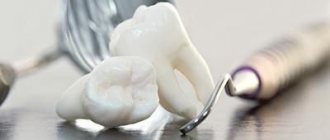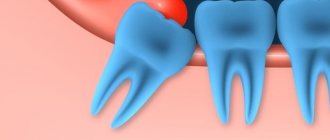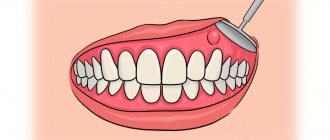Exostosis of the jaw is a benign formation that manifests itself in the form of an osteochondral growth (osteophyte). The protrusions can be single or multiple and are located on the jaw bone. Maxillary osteophytes most often form on the outer (buccal) surface of the alveolar ridge, and exostosis on the lower jaw - from the inside, on the lingual side. A palatal bone growth (palatal torus) is also found.
Exostoses are painless and do not cause any discomfort at an early stage. But as it increases, the formation begins to cause a lot of discomfort - it complicates eating, affects sound pronunciation, interferes with prosthetics, etc. Treatment of osteophytes is only surgical. Removing exostosis on the gum is a low-traumatic operation that takes about an hour. The operation is performed under anesthesia, so the patient does not experience any discomfort. The method of surgical intervention depends on the location of the osteophyte.
Reasons for appearance
It is not precisely determined why osteophytes appear on the gums. But factors contributing to the disease include:
- Hereditary predisposition;
- frequent inflammation, purulent processes leading to atrophy, deformation of the jaw bone and nearby tissues;
- injuries of the dental system, especially accompanied by fractures of the facial part of the skull with improper reposition of bone fragments;
- complex tooth extraction;
- advanced periodontitis, periodontal disease;
- bite pathologies;
- congenital abnormalities of the jaw.
Often the pathology appears in childhood or adolescence. Also, the appearance of jaw growths may be associated with dysfunction of the endocrine system.
After operation
For speedy healing after surgery, the patient should follow the following doctor’s recommendations:
- Don't overheat . Until the wound heals, avoid playing sports, visiting bathhouses, sunbathing on the beach and taking hot baths. An increase in temperature promotes bleeding from the wound.
- Gentle nutrition . During the healing period, avoid rough, dry, spicy and sour foods. You should also not eat food that is too hot or too cold. The consistency of the food should be liquid or puree.
- Avoid smoking . Nicotine and combustion products of tobacco impair wound healing.
Continue brushing your teeth, but avoid the surgical area with your toothbrush. After each meal, rinse your mouth with antiseptic solutions prescribed by your doctor. To relieve pain in the first days after surgery, take painkillers.
Symptoms
Exostosis of the tooth appears in the form of a convex growth that appears for no apparent reason. Main symptoms:
- Sensation of a foreign body in the mouth;
- discomfort when eating, talking (with large osteophytes);
- pain when pressing on the tumor;
- redness, thinning of the mucous membrane in the pathological area.
A small anomaly can only be detected during a dental examination, since visually it does not manifest itself in any way.
Treatment of exostoses
When diagnosing exostosis, treatment is prescribed only when symptoms appear. Otherwise, dynamic monitoring of the tumor is sufficient. If the tumor bothers the patient, depending on its type, the nature of the manifestation of osteochondroma, conservative treatment is selected or surgical intervention is prescribed. But the main method of treating exostosis is surgery.
Conservative, i.e., non-surgical, therapy is indicated mainly for exostosis of the calcaneus and rib, but only in the early stages of development. First of all, the use of special orthopedic insoles, made individually, and the replacement of regular shoes with models with offset edges are prescribed. This helps eliminate mechanical pressure on the tumor, reducing the load on the Achilles tendon and calcaneal tubercle.
If severe pain and inflammation occur, drug therapy is prescribed, including:
- NSAIDs in the form of topical agents (Nimid, Dolaren, Ketoprofen, Voltaren);
- drug blockades with the introduction of a mixture of anesthetics and corticosteroids (performed for severe pain that cannot be eliminated by other means).
Courses of physiotherapeutic procedures are also indicated. Shock wave therapy (SWT) is the most effective. It involves the impact of infrasonic acoustic waves on the affected area. The mechanism of action of the method is based on the cavitation effect that occurs at the interface between media. The acoustic resistance of soft tissue is less than that of bone. Therefore, sound waves penetrate through them and affect bones and cartilage. This provokes an improvement in blood supply, restoration of normal cartilage tissue and bones, and a reduction in the size of tumors.
Additionally, we may recommend:
- electrophoresis with the introduction of anesthetics;
- ultrasound therapy;
- laser therapy;
- Ural Federal District;
- magnetotherapy.
Why should jaw osteophytes be removed?
A bone growth on the gum is not dangerous until it begins to grow. Increasing in volume, the osteophyte puts pressure on the dentition and bone structures. This leads to tooth displacement, malocclusion, and jaw deformation. Large growths impede the movements of the tongue, complicate diction, and interfere with normal chewing of food. Large growths prevent prosthetics and implantation. Osteophyte of the jaw will not disappear on its own. The only effective method of treatment is surgical removal of the pathological formation.
Surgery to remove exostosis
Surgical intervention is indicated for:
- large size of osteochondroma and the presence of persistent pain;
- development of complications (tendinitis, bursitis, vascular, neurological disorders, etc.);
- bone deformations as a result of the growth of exostosis;
- fracture of the base leg;
- malignancy of the tumor.
For children with bone exostosis, surgery is prescribed only in extreme cases. As a rule, it is carried out only if the testimony remains after reaching adulthood.
But if there are contraindications, surgery is not performed. This:
- purulent-inflammatory processes in the area of the upcoming intervention;
- exacerbation of chronic diseases;
- decompensated form of diabetes mellitus;
- acute infectious diseases.
Treatment of exostosis with surgery involves its complete excision with capture of the cartilaginous cap. There are several methods for removing osteochondral growth. A specific one is selected based on the location of the osteochondroma and its size. Usually preference is given to marginal resection of the growth, i.e., its removal within healthy tissue. Only in some cases is it necessary to resort to corrective osteotomy with concomitant resection of osteochondroma, but the cost of removing exostosis in this way is higher, since the operation also corrects bone deformation.
After surgery, complete recovery is observed in 98% of cases. Therefore, almost everyone who has once removed an exostosis forgets about it forever.
Marginal resection is a relatively simple type of surgery. Its essence is to expose the affected bone and remove the entire neoplasm in the front of healthy tissue along with the surrounding capsule using a sharp chisel, drill, oscillating saw or bur. After removal of the pathological formation, curettage of the maternal bone is performed using cutters and bur. In some cases, the extent of resection can be large and create the need for bone grafting using autografts or special implants. It is important to remove the entire cartilaginous cap and neoplasm, otherwise a relapse may develop.
Carrying out a corrective osteotomy involves cutting the mother's bone using an osteotome and removing the osteochondroma. After this, the bone fragments are fixed in the desired position using special plates, screws or knitting needles.
Indications
- Rapid growth of osteophyte;
- exostosis after wisdom tooth removal;
- discomfort, pain;
- the appearance of cosmetic defects on the lower or upper jaw (they look like white balls on the jaw, noticeable when smiling or talking);
- the need for implantation, removable or fixed prosthetics;
- the risk of tumor transformation from benign to malignant.
If you need to install prostheses or implants, exostoses will become an obstacle to the procedure. Dentures will injure the bone growth on the gum, and implants will not be able to take root normally in the bone due to the pressure of osteophytes.
Classification
The classification is based on several characteristics. Based on quantitative characteristics, solitary (single) and multiple (generalized) forms are distinguished.
According to the stages of osteochondroma formation:
- The neoplasm is formed from cartilaginous tissue and cannot be detected by palpation.
- Ossification of the growth and its increase. The bone tissue is covered with cartilage, and active growth continues.
- The growth of the bone part of the tumor stops, but the growth of the cartilaginous “cap” of the tumor may continue. Determined by palpation examination. During physical activity, it can manifest as pain and impaired limb function.
Based on the shape and direction of tumor growth, there are hill-shaped, linear and spherical exostoses.
Grodno Regional Children's Clinical Hospital
Details Published May 28, 2021
Exostosis
Exostosis - (osteochondroma, cartilaginous exostosis, osteochondral exostosis, bone spur) is a bone or osteochondral benign growth on the surface of the bone, covered throughout with periosteum and can be covered with a cartilaginous “cap”.
The reasons for the development of exostosis are different. There is a familial hereditary nature. The occurrence of exostosis is possible after injury (if the periosteum is damaged), an inflammatory process, hypothermia, radiation, and as a result of certain diseases (rheumatism, gout, syphilis, diabetes mellitus, osteomyelitis). The most common localization is the rib, clavicle, metadiaphyses of long tubular bones. Osteochondromas can be located
in the skull. There are single and multiple (osteochondromatosis) exostoses. There are various shapes (linear, spherical, flask-shaped, beak-shaped, spiky) and sizes (can reach 5 cm or even more).
Clinic
The growth of exostosis is slow. Intensive growth is more often observed during the period of physiological growth of the skeleton (8-18 years). With the rapid dynamics of exostosis, one should think about its malignant degeneration. Most often, slowly growing exostoses are asymptomatic and detected accidentally. They are detected during an X-ray examination when a compaction appears, palpable under the skin or visible during examination. Exostosis can only manifest itself as an aesthetic defect or put pressure on neighboring organs and neurovascular bundles. There may be varying degrees of pain (from mild to severe), depending on the size and location of the formation. There may be different lengths of the arms or legs (if the knee or shoulder joint is affected), lower height compared to the average age values (if the hip is affected), pain during physical activity (if the tumor is located under the tendon), sensory disturbances or cramps (if the hip is affected). nerve endings), blurred vision or drooping eyelid (with exostosis in the paranasal sinuses), epilepsy (when located on the inner surface of the skull).
Diagnostics
X-ray, MRI/CT studies allow us to judge the number of exostoses, shape, size, position and structure. On photographs and scans, exostosis is a formation of a bone structure, with clear contours, connected to the medullary canal by a wide/narrow base, with a continuous cortical layer (at the base of the exostosis there is no underlying cortical layer), a painful synovial bursa may form above the cartilaginous capsule. Damage to soft tissues and a cartilaginous “cap” (the thickness of which should not exceed 10 mm in an adult; 10-20 mm is an intermediate lesion; the formation is considered tumorous if it exceeds 20 mm; in children, the “cap” can normally reach 2 cm per period growth) can only be detected by magnetic resonance imaging.
Differential diagnosis
Differential radiodiagnosis is carried out with ecchondroma, secondary chondrosarcoma, subperiosteal hematoma, subungual exostosis (Dupuytren's subungual exostosis), Tourret's exostosis; hemimelic epiphyseal dysplasia (Trevor's disease), abnormal paraosteal osteochondromatous proliferation (Nora's disease), juxtacortical chondroma, parosteal osteosarcoma.
Treatment
Treatment of exostoses is only surgical. Performed for compression of a large nerve/vessels, pain syndrome, malignancy and for aesthetic reasons. For small formations, laser burning is possible.
Prognosis and complications
Osteochondroma can recur 1-26 months after removal of the primary formation (with incomplete removal of the cartilaginous “cap”). A serious complication is malignant degeneration (the structure most often corresponds to chondrosarcoma, chondromyxosarcoma and spindle cell sarcoma). Thrombosis of the popliteal vein and the development of a false aneurysm of the popliteal artery may occur. Sometimes bone fractures are complications of exostoses.
MRI doctor Yaroshchuk I.G.
Diagnostics
Sometimes bone spurs can reach significant sizes and take on unusual shapes with no or minimal symptoms of pain. They must be differentiated histopathologically from, for example, tumors of mesenchymal origin such as osteochondroma or osteochondroma. For this purpose, the dentist, after visual examination and palpation of the exostosis, refers the patient for examination:
- X-ray – accurately shows the size and location of the formation, its position in relation to the roots of the teeth and other elements of the dental system.
- Biopsy - cytological examination is necessary for the differential diagnosis of benign formation.










